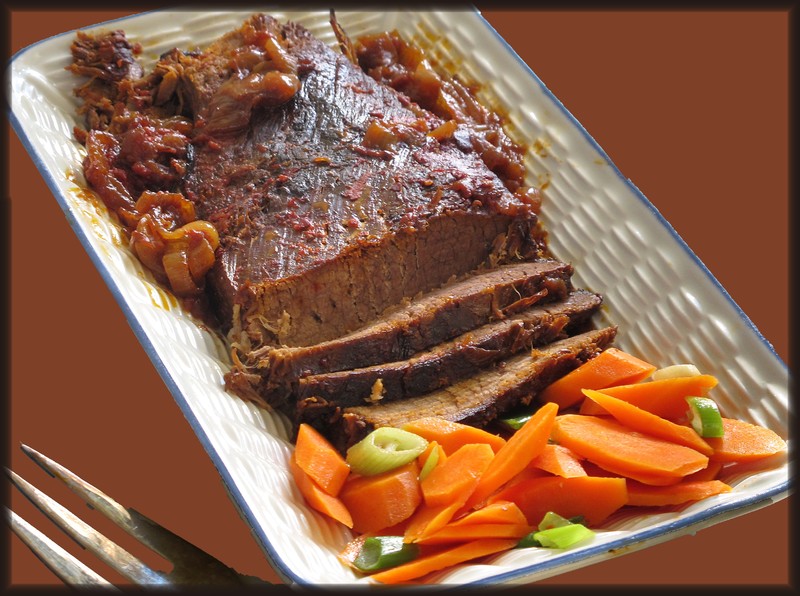Prices in the butcher section of the supermarket have started to reflect something good cooks have always known. Cheaper cuts of meat can become the centerpiece of an extraordinary dining experience when they’re handled the right way. Braising and other slow-cooking techniques can transform a tough piece of beef into a delicious dish. Now that the secret’s out, it comes as no surprise that the formerly second-tier cuts of meat are being sold at higher prices. Take the brisket, for example.
Brisket comes from the chest or pectoral muscles of the cattle, the area covering their first five ribs. Without a collarbone to help support and distribute the animal’s weight, the brisket muscles are largely responsible for keeping the animal upright and ambulatory. As a result, this cut of beef is full of connective tissue that can make its texture very tough. Unless you know how to cook it.
But, before we start in the kitchen, let’s consider what to look for at the meat counter. If you want an entire brisket, known as the packer cut, you’ll find them available at online gourmet vendors and wholesale shopping clubs. Typically between 10 and 12 pounds, this large piece of meat can be cooked as is, or trimmed into its two component pieces: the point and the flat.
A conventional grocery will have already done this knife work and packaged the trimmed meat without its generous coating of fat. The top piece is called the deckle or point; the bottom, leaner section is sold as first cut. The difference in price between the whole brisket and the trimmed sections can be as much as$3 a pound, which is somewhat surprising: the butcher subtracts flavor when they trim the fat. Properly butchered brisket will retain a layer of surrounding fat; you don’t want a piece that is completely bare.
If you can only choose from the offerings at your market, find a piece that is uniformly thick, two inches is ideal; avoid any that taper down to a paper-thin corner.
Look for white-colored fat (not yellow) as a sign the animal was fed some grain. Check the meat from the side to make sure it’s evenly marbled (no large globs of fat). If selecting between a flat or a point, select the latter as it has a little more fat, which keeps the meat moister while in the oven.
Now for the cooking process: long and slow. Remember, we’re not talking about boiling corned beef brisket, which is another thing entirely. This type of brisket should be treated more like a pot roast. You want to melt away all that connective tissue, leaving behind succulent, tender beef. The other key to the flavor is what you add to the roasting pan. I’ve seen recipes calling for everything from Coca Cola to powdered onion soup mix to chili sauce. There’s no right answer, except to make sure you include lots and lots of sliced onions.
If you have the entire packer’s cut, use the basic recipe. You won’t need any liquid, because the vegetables will release enough to make a sauce. If you’re cooking a first cut or deckle section, try the recipe for trimmed brisket. This includes liquid as well as the essential mountain of onions to maintain enough moisture. Be prepared for some of the fat to persist on the meat; trim it off as you plate the servings.
Most brisket does well after an overnight in the refrigerator. You can skim out any pieces of solidified fat before reheating the meat and concentrating the sauce. No matter whether you serve it immediately or the following day, always carve the brisket against the grain, into slices about one-quarter of an inch thick. If you can’t cut perfect slices, keep in mind the brisket-lovers who insist the sign of a perfectly cooked brisket is meat too tender to slice.
Whole Brisket
10 lb whole brisket (packer cut)
4 lbs onions, sliced
1 lb carrots, sliced
3 stalks celery, sliced
salt and pepper, to taste
Preheat oven to 350 F. Trim some of the excess fat from the top of the meat, if needed; leave at least 1/2 to 3/4 inch. Do not separate the top and bottom sections of the brisket; leave the fatty layer between them intact. Spread the vegetables across the bottom of a large roasting pan. Place the brisket on the vegetables and sprinkle generously with salt and pepper. Tightly cover the pan with aluminum foil. Bake until tender, about 4 hours. Remove from oven and allow to rest (still covered) for at least 20 minutes. To serve, slice through the fat layer separating the top from the bottom section. Trim any excess fat and carve each section into 1/4 inch slices, cutting against the grain at a slight angle with a serrated knife. Skim fat from the pan liquids and discard. Serve sliced beef with wilted onions and a ladle of pan juices. Yield: 8 to 10 servings.
Trimmed Brisket
1 T olive oil
3 lb trimmed brisket
1/2 t salt
1/2 t pepper
3 sliced onions
2 T Balsamic vinegar
3 T tomato paste
1 1/2 C red wine
Preheat oven to 325 F. Heat olive oil in an ovenproof skillet. Sprinkle meat with salt and pepper. Brown meat on both sides over medium heat. Remove to a platter. Add onions to the same skillet and cook until softened. Deglaze the pan with Balsamic vinegar and scrape up any browned bits from the pan.
Spread half the onions evenly across the bottom of the pan and place the meat on top along with any juices it has released. Spread tomato paste across the top of the meat and cover with remaining onions. Pour wine into pan, cover and cook for approximately 4 hours.
To test whether the meat is done, try to break off a piece with a fork; it should give easily. If not cooked enough, return to oven with additional wine, if needed.
To serve, carve meat into 1/4 inch slices, cutting against the grain at a slight angle with a serrated knife. Plate slices with wilted onions and pan drippings.
Reheating brisket
After cooking the brisket, cover and refrigerate overnight. About 3 hours before serving time, remove from the refrigerator and skim off any hardened fat from the surface of the meat and pan liquid.
About one hour before serving, preheat oven to 325 F and carve the room temperature meat into slices one-quarter inch thick. Keep the slices together and return them to the same pan, retaining the original shape of the whole brisket. Bake, uncovered for about 45 minutes, basting often with the pan drippings.




















































